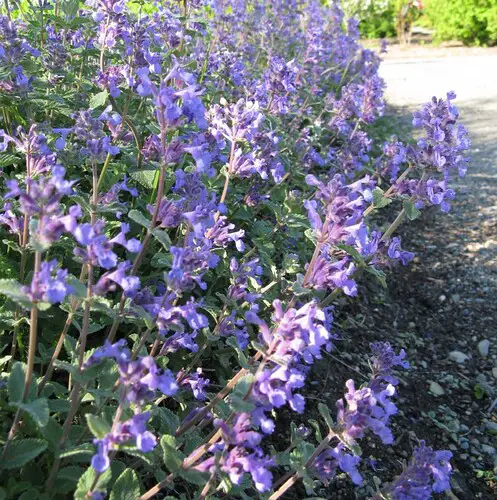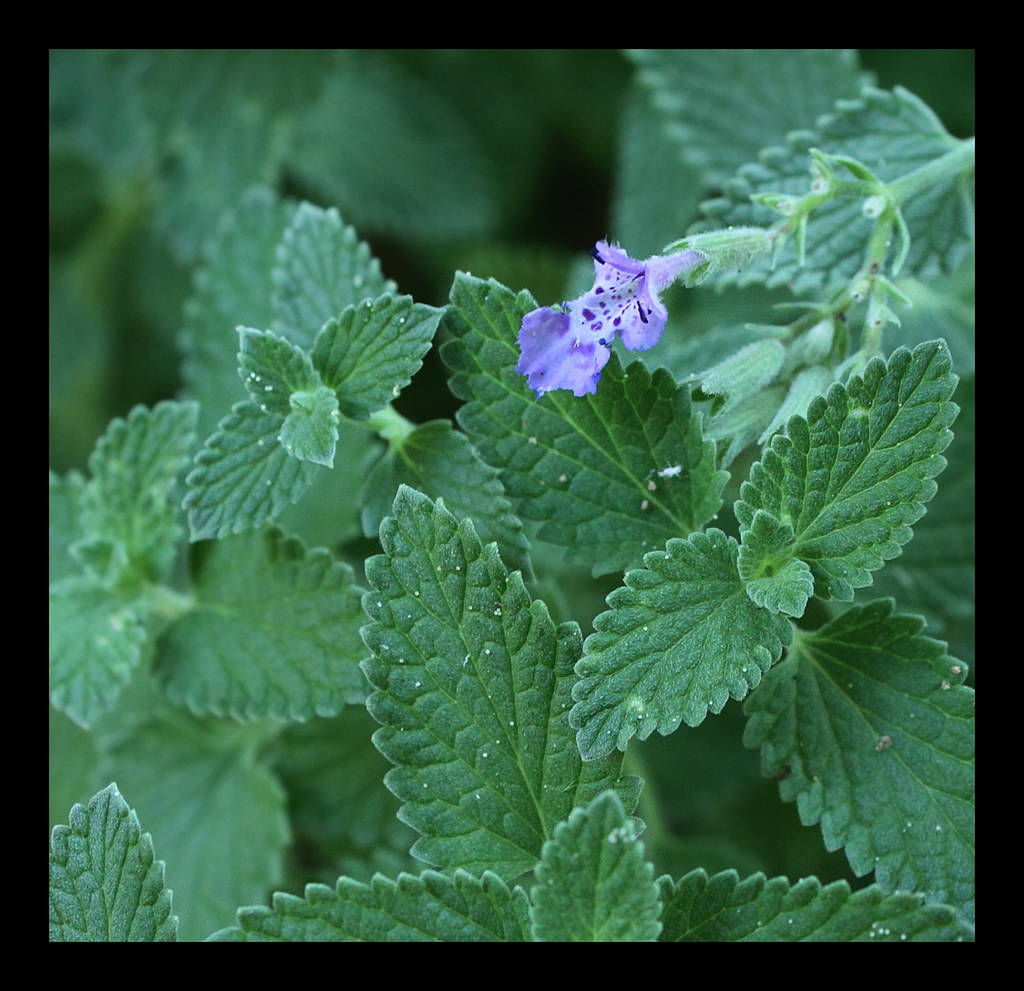Lavender Vs Catmint: What’s The Difference? Catmint and lavender are both popular plants that are widely used in cottage gardens around the world. Both plants are extremely drought tolerant and have greenish-grey foliage and purple flowers. So what are the differences between these plants and which one should you be planting in the garden?
Both catmint and lavender are members of the Lamiaceae Family or the mint family, however they are not closely related plants as they come from two different genus. Both plants are scented, though lavender is generally more prized for its scent than catmint.
In terms of there size both plants do vary from relatively low growing species that typically reach around 1 ft to 2 ft tall to varieties that are approximately 3 to 5 ft tall. The larger varieties of lavender are generally a little taller than the biggest varieties of catmint which usually only reach 3 to 4 ft tall
The low-growing varieties of catmint, such as low Walker, are generally the most popular varieties because they are often used as ground covers at the front of herbaceous borders. They are particularly useful in this setting because they have a thick matted root system that tends to outcompete any weeds that are present reducing the maintenance of the garden.
In terms of their leaf shape catmint has a broader leaf that has a shape that is not dissimilar to common mint where has lavender tends to have relatively narrow Leaf that is more similar to Rosemary in its shape though it is not complete spine-like like rosemary.
About Catmint
Catmint is a group of plants from the nepeta genus which includes approximately 250 different species. The plants are native to Africa, Asia, and Europe and contain catnip as well as catmint. Catnip is a plant that has a narcotic effect upon cats of all sizes including domestic house cats and big cats. This effect is caused by a chemical called nepetalactone which creates a temporary euphoria. To read more about this click here.
The majority of plants within this group are herbaceous perennials that produce tubular flowers that are most commonly blue but there are also forms that have white, pink, and lilac flowers.
These flowers appear on moderately sized flower spikes that are typically 4 to 6 inches long. These flowers blooms appear for an extended period of time from late spring to autumn.
They are generally suited to a range of climates and will tolerate dry conditions and are excellent for attracting pollinators. Additionally, they are considered to be deer resistant and have even been known to repel dear.
Catmint plants do spread easily and will take over a section of the garden over time. However, when you compare it to other plants from the mint family including things like common mint it is generally not considered as aggressive as these plants.
The plant can spread by both seed and via it’s root system and you will find that it will pop up in adjacent garden beds very regularly. It is generally not difficult to control or remove from the garden beds which means that I generally do not consider it to be invasive.

How To Grow Catmint
Catmint is generally easy to grow and can be purchased as a plant or grown from seed, which is commercially available. To grow the plant from seed start by filling a seed tray with a good quality seed raising mix and then plant the seeds into the soil to a depth of 0.5 inches (1 cm). The best time to do this is in mid-spring as it will allow the plant to become established throughout the growing season before the cooler winter months.
Once the seeds have been planted water them in well and ensure that the soil remains moist throughout the germination period. Catmint seedlings will typically appear 7 to 14 days after they are planted and they ideally need to spend 6 to 8 weeks in a seed tray before they are potted on or planted in the garden.
I personally prefer to pot them on to allow the plant to get a little bit larger before placing them in the garden. When putting the plants out in the garden they should be placed in a sunny location and Spaced approximately 1.5 to 2 feet apart.
In terms of soil conditions, the plants generally prefer soil that is rich moist and free draining. Once the plant is planted in the garden it should be watered in well and then have a thick layer of mulch applied to the surrounding soil to minimise moisture loss.
Catmint is generally easy to look after and requires very little maintenance however in the first season it is advisable to water the plant regularly while the roots are getting established. After this period the plant will become tolerant of dry conditions.
To keep the plants looking good it is advisable to remove the flower spikes from the plant at the end of the season. This time of the year is also ideal for dividing catmint if you want additional plants which is extremely easy to do.
Simply dig up the plant and then slice the root ball in half and replant the new sections in the desired locations. As the plant is extremely tough you do not need to be gentle with it as the plant will survive.

About Lavender
Lavender refers to 47 different species that belong to the Lavandula genus. Lavender originated in Europe, Africa, and southwest Asia and is now widely grown in home gardens and also used for the commercial extraction of essential oils which has a long history in medical and cosmetic applications.
The plant itself is a relatively short-lived herbaceous perennial plant that is extremely drought tolerant. However the plant does have a tendency to become woody over time and does require regular pruning on an annual basis to prevent this from happening. In this regard lavender is a slightly higher magnets plant than catmint.
How To Grow Lavender
Lavender can be grown in much the same way as catmint. It can be purchased as a shrub from garden centres or grown from seed which is also widely available. If you choose to grow the plant from seed the best time to do this is in spring when the weather is starting to warm up.
To grow the plant from seeds you can plant it directly into the garden or alternatively into a seed tray. I personally prefer to plant into a seed ray as it is much easier to control the climatic conditions. Seeds should be sown at a depth of approximately 0.5 inches and ideally need to be planted into a soil mixture that is moist throughout the germination period. Seed raising mix is ideal for this purpose
Lavenders are plants that can be slow to germinate and will take quite some time to reach a reasonable size. Typically you can expect seedlings things to appear anywhere from 12 to 24 days after planting and they will typically need to spend at least 6 to 8 weeks in the seed tray before being planted on into a larger pot.
If you leave them in the seed tray the lavenders will remain small so it is advisable to transfer them to a larger pot as soon as possible and then allow them to develop to a size of approximately 4 to 6 inches in height before planting them out in the garden.
When planting them in the garden they should ideally be planted in a rich soil that is relatively moist but free-draining as lavender hates wet feet.

The plant will take the best part of the first season to establish its root system during this period it is important that you supplement any rainfall with regular watering to ensure the plant does not dry out. However, after this period the plant will become quite drought tolerant, and regular watering will not be necessary unless there is an extremely long dry spell.
The plant should be regularly pruned at least once a year to ensure that it maintains its shape. When pruning it is important not to cut the branches below where there is leaf growth on the stems. The reason for this is that the branches will not recover.
If you do not do this regular maintenance you will find that the plant will become woody and sparse over an extended period of time which will be difficult to correct once this occurs.
I hope you found this article useful. If you have any questions or comments please leave them in the section below
Relevant Articles
Is Catnip And Catmint The Same? What Are The Differences?
Is Catmint Edible? If So, What Is It Used For?
How To Tell The Difference Between Lavender And Russian Sage (Are They The Same?)
Can You Propagate Lavender In Water? (Here’s How To Do It)
